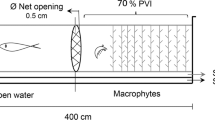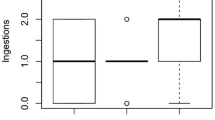Abstract
Community level effects of predation by two invertebrate predators, the opossum shrimp (Neomysis intermedia), and the larva of the phantom midge (Chaoborus flavicans) were studied and compared.
N. intermedia appeared abundantly in the shallow eutrophic Lake Kasumigaura and had a significant impact on the zooplankton community. The predation pressure by Neomysis was highest on cladocerans, followed by rotifers, and finally copepods. At high densities (maximum nearly 20 000 individuals m−2), Neomysis excluded almost all cladocerans, rotifers and copepods from the lake.
Zooplankton communities were established in experimental ponds, into which C. flavicans was introduced. The predator's density was around 1 individual l−1, and was probably controled by cannibalism. Although Chaoborus larvae feed on various zooplankton species, their predation impact on zooplankton populations was markedly selective. They eliminated medium- and small-sized cladocerans and calanoid copepods from the ponds, but rotifers increased.
Although the feeding selectivities of Neomysis and Chaoborus individuals were similar, the predation effects on zooplankton communities by the two predators were different.
Similar content being viewed by others
References
Brandl, Z. & C. H. Fernando, 1978. Prey selection by the cyclopoid copepods Mesocyclops edax and Cyclops vicinus. Verh. int. Ver. Limnol. 20: 2505–2510.
Brooks, J. L. & S. I. Dodson, 1965. Predation, body size, and composition of plankton. Science 150: 28–35.
Dodson, S. I., 1974. Zooplankton competition and predation: an experimental test of the size-efficiency hypothesis. Ecology 55: 605–613.
Dumont, H. J., 1977. Biotic factors in the population dynamics of rotifers. Arch. Hydrobiol. Beih. 8: 98–122.
Edmondson, W. T. & A. H. Litt, 1982. Daphnia in Lake Washington. Limnol. Oceanogr. 27: 272–293.
Fedorenko, A. Y., 1975. Instar and species-specific diets in two species of Chaoborus. Limnol. Oceanogr. 20: 238–249.
Gilbert, J. J., 1988. Suppression of rotifer populations by Daphnia: A review of the evidence, the mechanisms, and the effects on zooplankton community structure. Limnol. Oceanogr. 33: 1286–1303.
Goldman, C. R., M. D. Morgan & S. T. Threlkeld, 1979. A population dynamics analysis of the cladoceran disappearance from Lake Tahoe, California-Nevada. Limnol. Oceanogr. 24: 289–297.
Grygierek, E., A. Hillbricht-Ilkowska & I. Spodniewska, 1966. The effect of fish on plankton community in ponds. Verh. int. Ver. Limnol. 16: 1359–1366.
Hanazato, T. & M. Yasuno, 1985. Population dynamics and production of cladoceran zooplankton in the highly eutrophic Lake Kasumigaura. Hydrobiologia 124: 13–22.
Hanazato, T. & M. Yasuno, 1987. Characteristics of biomass and production of cladoceran zooplankton in Lake Kasumigaura. Jap. J. Limnol. 48: S45-S57.
Hanazato, T. & M. Yasuno, 1988. Impact of predation of Neomysis intermedia on a zooplankton community in Lake Kasumigaura. Verh. int. Ver. Limnol. 23: 2092–2098.
Hanazato, T. & M. Yasuno, 1989. Zooplankton community structure driven by vertebrate and invertebrate predators. Oecologia, 81: 450–458.
Hanazato, T. & M. Yasuno, 1990. Influence of Chaoborus density on the effects of an insecticide on zooplankton communities in ponds. Hydrobiologia, in press.
Hare, L. & J. C. H. Carter, 1986. The benthos of a natural West African lake, with emphasis on the diet migrations and lunar and seasonal periodicities of the Chaoborus populations (Diptera, Chaoboridae). Freshwat. Biol. 16: 759–780.
Hurlbert, S. H., J. Zedler & D. Fairbanks, 1972. Ecosystem alteration by mosquitofish (Gambusia affinis) predation. Science 175: 639–641.
Hurlbert, S. H. & M. S. Mulla, 1981. Impacts of mosquitofish (Gambusia affinis) predation on plankton communities. Hydrobiologia 83: 125–151.
Kasuga, S., 1982. Feeding preference of Neomysis intermedia and its ecological niche in Lake Kasumigaura. Surv. Rep. Natnl. Inst. Envir. Stud. 22: 139–147. (in Japanese).
Lane, P. A., 1979. Vertebrate and invertebrate predation intensity of freshwater zooplankton communities. Nature 280: 391–393.
Lazzaro, X., 1987. A review of planktivorous fishes: Their evolution, feeding behaviours, selectivities, and impacts. Hydrobiologia 146: 97–167.
Lewis, W. M. Jr., 1977. Feeding selectivity of a tropical Chaoborus population. Freshwat. Biol. 7: 311–325.
Lynch, M., 1979. Predation, competition, and zooplankton community structure: an experimental study. Limnol. Oceanogr. 24: 253–272.
Murtaugh, P. A., 1981. Selective predation by Neomysis mercedis in Lake Washington. Limnol. Oceanogr. 26: 445–453.
Neill, W. E., 1984. Regulation of rotifer densities by crustacean zooplankton in an oligotrophic montane lake in British Columbia. Oecologia 61: 175–181.
Neill, W. E., 1985. The effects of herbivore competition upon the dynamics of Chaoborus predation. Arch. Hydrobiol. Beih. 21: 483–491.
O'Brien, W. J., N. A. Slade & G. L. Vinyard, 1976. Apparent size as the determinant of prey selection by bluegill sunfish (Lepomis macrochirus). Ecology 55: 1042–1052.
O'Brien, W. J., 1979. The predator-prey interaction of planktivorous fish on zooplankton. Am. Sci. 67: 572–581.
Pastorok, R. A., 1980. Selection of prey by Chaoborus larvae: a review and new evidence of behavioral flexibility. In: W. C. Kerfoot (ed.), Evolution and Ecology of Zooplankton Communities: 538–554. The University Press of New England, Hanover, N.H.
Pastorok, R. A., 1981. Prey vulnerability and size selection by Chaoborus larvae. Ecology 62: 1311–1324.
Post, J. R. & D. J. McQueen, 1987. The impact of planktivorous fish on the structure of a plankton community. Freshwat. Biol. 17: 79–89.
Richards, R. C., C. R. Goldman, T. C. Frantz & R. Wickwire, 1975. Where have all the Daphnia gone? The decline of a major cladoceran in Lake Tahoe, California-Nevada. Verh. int. Ver. Limnol. 19: 835–842.
Rieman, B. E. & C. M. Falter, 1981. Effects of the establishment of Mysis relicta on the macrozooplankton of a large lake. Trans. am. Fish. Soc. 110: 613–620.
Saunders, J. F. III & W. M. Lewis, Jr., 1988. Composition and seasonality of the zooplankton community of Lake Valencia, Venezuela. J. Plankton Res. 10: 957–985.
Shei, P., T. Iwakuma & K. Fujii, 1988. Feeding of Chaoborus flavicans larvae (Diptera: Chaoboridae) on Ceratium hirundinella and Daphnia rosea in a eutrophic pond. Jap. J. Limnol. 49: 227–236.
Takamura, N., T. Iwakuma & M. Yasuno, 1984. The biomass and production of phytoplankton in Lake Kasumigaura during 1981–1983. Res. Rep. Natl. Inst. Envir. Stud. 51: 11–56.(in Japanese with an English abstract).
Threlkeld, S. T., J. T. Rybock, M. D. Morgan, C. L. Folt & C. R. Goldman, 1980. The effects of an introduced invertebrate predator and food resource variation on zooplankton dynamics in an ultraoligotrophic lake. In: W. C. Kerfoot (ed.), Evolution and ecology of zooplankton communities: 555–568. University Press of New England, Hanover, N.H.
Toda, H., M. Takahashi & S. Ichimura, 1982. Abundance and life history of Neomysis intermedia Czerniawsky in Lake Kasumigaura. Hydrobiologia 93: 31–39.
Toda, H. & M. Takahashi, 1985. High mortality of juveniles during the summer decline of the mysid (Neomysis intermedia) population in Lake Kasumigaura. Bull. Plankton Soc. Jap. 32: 141–148.
Vanni, W. J., 1986. Competition in zooplankton communities: suppression of small species by Daphnia pulex. Limnol. Oceanogr. 31: 1039–1056.
Warshaw, S. J., 1972. Effects of alewives (Alosa pseudoharengus) on the zooplankton of Lake Wononskopomuc, Connecticut. Limnol. Oceanogr. 17: 816–825.
Wells, L., 1979. Effects of alewife predation on zooplankton populations in Lake Michigan. Limnol. Oceanogr. 15: 556–565.
Winner, R. W. & J. S. Greber, 1980. Prey selection by Chaoborus punctipennis under laboratory conditions. Hydrobiologia 68: 231–233.
Zaret, T. M., 1980. Predation and freshwater communities. Yale University Press. New Haven, 187 pp.
Author information
Authors and Affiliations
Rights and permissions
About this article
Cite this article
Hanazato, T. A comparison between predation effects on zooplankton communities by Neomysis and Chaoborus . Hydrobiologia 198, 33–40 (1990). https://doi.org/10.1007/BF00048620
Issue Date:
DOI: https://doi.org/10.1007/BF00048620




